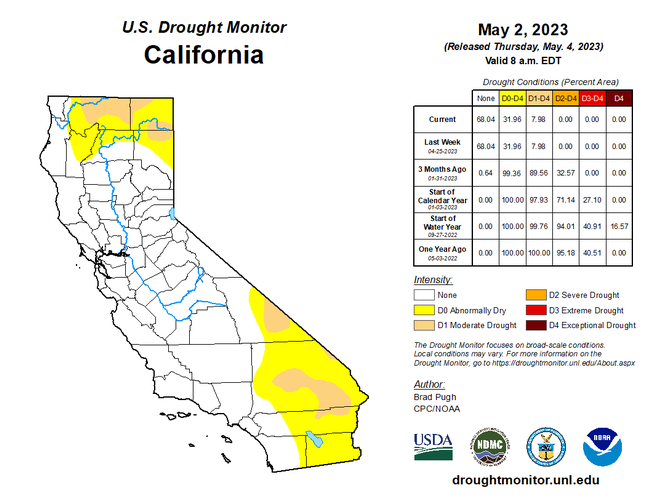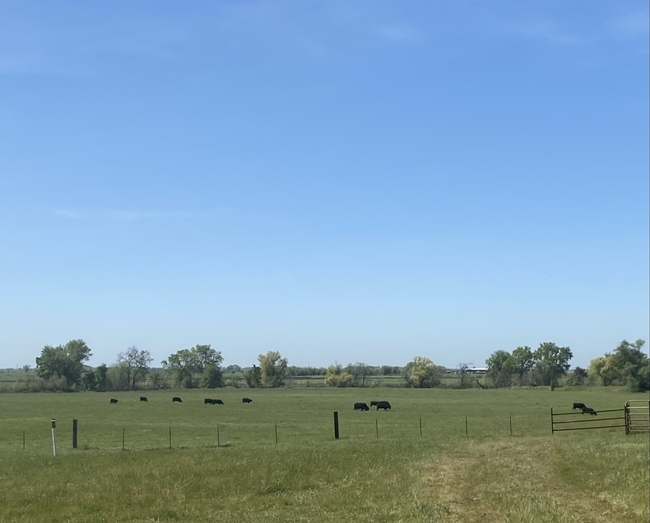Fair warning - you might want to file this blog post under the category, "Aren't Ranchers Ever Happy?!" I'll admit - last year, I was worried about warm temperatures, lack of soil moisture, and dried-up stock ponds here in the Sierra Foothills. We'd had the driest January-March ever recorded. Seasonal creeks weren't running. A lack of stock water was limiting access to some pastures for ranchers in my four counties. But thanks to an early start to the grass season (a germinating rain in October) and warmer-than-usual temperatures, followed by rain (at last) in April 2022, we had plenty of grass from Yuba County south through Placer County. According to the Sierra Foothill Research and Extension Centern (SFREC) in Browns Valley (Yuba County), we had 3,806 pounds of forage per acre on May 1, 2022 - 20 percent more than the historical average for that date. Total precipitation from October 2021 through September 2022 was 21.2 inches - about 17 percent lower than the historical average.
The year before that (the 2020-21 water year) was even stranger. That year, SFREC measured just 10.57 inches of precipitation - the driest year since 2000 (drier, even than the worst of the drought years of 2013-2015). Even with the lack of moisture, however, the grass grew - total production was 108 percent of the historical average (3,382 pounds per acre). Once again, most seasonal creeks didn't run. Spring-fed stock water systems failed. But we had grass.
So where do we stand this year? The 2022-23 water year has been phenomenal. We have a near-record snow pack here in the northern Sierra Nevada. The southern Sierra Nevada has the most snow ever recorded! The creeks are running! Ponds are full! The May 2, 2023 Drought Map shows our region of the Sierra Foothills has escaped the drought!
And we're seeing less forage on May 1, 2023, than we saw in either of the last two drought years!
How can this be?! As of today, SFREC has measured just under 35 inches of rain since October 1 - 42 percent more than "normal." But the May 1 forage production figures are below average - just over 3,000 pounds per acre (about 4 percent under the historical average). What's going on here?
Annual rangelands are notoriously complex (in terms of biodiversity, phenology, and productivity). We've known for some time that forage production on our foothill rangelands has as much to do with the timing of precipitation as it does with the total amount. Forage production also depends on adequate soil and air temperature - warmer soils and warmer ambient air temperatures, given adequate moisture, result in greater forage production. Colder temperatures and cloudy days, on the other hand, tend to work against grass growth - as we've seen during this unusually chilly spring in the foothills.
We also know that photo period - the number of daylight hours - plays a role. I've usually thought of this in terms of winter dormancy - in early December, the days are short enough that the grass goes dormant here in the foothills, regardless of moisture or temperature. This year, however, is teaching me that photo period may be equally important in controlling when our rangeland plants flower and set seed. Even though we still have tremendous soil moisture in our rangeland pastures, I'm seeing many of our annual grasses and broadleaf plants "head out" and go to seed - they're just about done growing, despite what seem like favorable conditions. As any rancher will tell you, as soon as our annual forages go to seed, they drop in palatability and nutritional value.
I'll admit, I can't truly bring myself to call this a drought year. I can live with 96% of normal forage production - it's considerably better than the 2100 pounds per acre we had on May 1, 2015 (when I managed the cow herd at SFREC). But this year is an important reminder about how complex our grazing systems truly are. Carrying capacity fluctuates from one year to the next - and from one month to the next. Our job as ranchers is to build enough flexibility into our management systems to allow us to "weather" the valleys in forage production, and benefit from the peaks!
